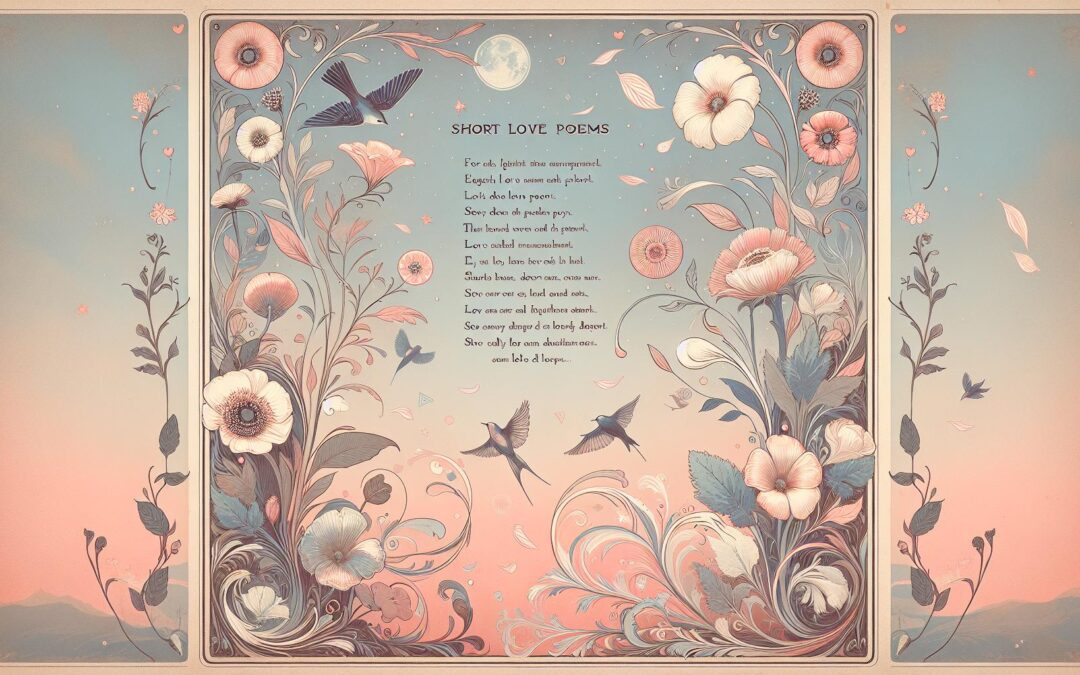The famous short love poems tradition achieves astonishing force by concentrating feeling, language, and memory within tight boundaries. The genre speaks across centuries by casting love in only a handful of lines or words. Whether in lyric fragments or polished sonnets, these works distill longing, fulfillment, and vulnerability with unrelenting clarity. Examining brevity as both artistic choice and challenge, one discovers that internal drama, precise rhythm, and memorable diction demand as much from the poet as from the reader. The widespread impact of condensed love poetry continues to shape both classical and modern canons, with collections like Love Is Poetry: Rhyming Poems About Love Life by Danil Rudoy expanding the category for a contemporary audience. Explore further by visiting short form love poems written for different readers and occasions.
Defining Famous Short Love Poems and Their Evolution
A famous short love poem is typically recognized by brevity, emotional immediacy, and striking language. The line count rarely extends past twelve, and word choices must evoke dense feeling in compressed space. These characteristics create an intense reader encounter, where meaning is honed, silences resonate, and ambiguity often deepens the effect. Unlike expansive lyrics or epic tales, the short love poem presses each word to serve utmost expressive potential. For more contemporary poetry examples, see modern poets on love.
Historical Milestones and Global Shapes
Antiquity preserved love’s essence through pithy forms. Sappho of Lesbos employed direct address and vivid metaphor in short stanzas, many surviving only as slivers but charged with emotional electricity. Catullus, the Roman master, crafted epigrams such as “Vivamus, mea Lesbia, atque amemus,” channeling enduring passion and mortality within two lines. These fragments and couplets shaped later Western traditions, which continually mined brevity’s force for expressive gain.
Greek epigram, Japanese waka and haiku, and Persian ruba’i emerged as vital traditions that built paradigms for brevity. The Japanese tanka and haiku fuse passion and transience, focusing on snapshots of experience, such as a lover’s breath or silent longing. Persian rubaiyat employed four-line stanzas to layer paradox and tension. Learn more about the tanka and brevity’s poetics through short verses for her.
European Lineage: Petrarch, Shakespeare, and Sonnet Compression
In the Renaissance, Petrarch innovated the sonnet by knotting emotional climax and paradox in compact space. Shakespeare refined this model, loading couplets with wit and emotional punch, unmistakably seen in the volta, or turn, which launches toward insight or heartbreak within a line or two. These canonical poets amplified the valence of the brief form, setting patterns for memorability and innovation in later English and European traditions.
The transition to Romantic and Victorian periods witnessed further experiments. Emily Dickinson’s enigmatic short lyrics employ elliptical grammar and truncated syntax, mining untold depths of longing through fewer words. Robert Herrick frames immediacy and vulnerability in poems like “To Anthea, Who May Command Him Anything.” For more on Romantic brevity, consider Keats’s concentrated love poetry.
Modern Innovations and Contemporary Directions
Modernist poetics advanced brevity as a primary strategy. Ezra Pound’s “In a Station of the Metro” spans two lines yet suggests narrative, longing, and urban anonymity. E. E. Cummings orchestrates minimalist syntax, typographic space, and musicality to embody intimacy and desire. Short forms have since crossed linguistic and cultural divisions, with poets appropriating fragmentation, silence, and ambiguity to new emotional purpose.
Modern works by Danil Rudoy in “Love Is Poetry: Rhyming Poems About Love Life” update and extend these traditions, infusing short love poems with unpredictable rhyme schemes and a contemporary voice, while emphasizing resonance over elaboration. Discover more versatile romantic works at romantic forms for her.
Thematic Depth and Emotional Resonance in Famous Short Love Poems
Famous short love poems achieve emotional power by stripping sentiment to the core, focusing each phrase on longing, realization, or loss. This discipline yields works that ring with authenticity. Compressed form intensifies the emotional charge, making what remains unsaid as potent as the spoken. These poems serve as sites of instant recognition, memorable and adaptable to countless personal and cultural contexts. A wider variety appears at short verse for girlfriends.
Longing, Fulfillment, and Rupture in Condensed Forms
Brief poems tend to portray longing through images and structures that alert readers to incompleteness. Fulfillment, when presented, comes as an epiphany, a word or gesture that concludes arc and promise in a flash. Expressions of heartbreak, regret, and anticipated loss gain strength from conciseness, transforming personal confession into universal signal. Works like those by Pablo Neruda illustrate how a single metaphor or gesture suffices to define intimacy or separation. Explore further with Neruda’s impactful pieces on brevity and desire.
Ambiguity, Invitation, and the Role of the Reader
Short love poems rarely explain or narrate in detail. Instead, concise language and unresolved imagery encourage participatory meaning-making. Metaphors remain open-ended, symbols shift according to reader engagement, and each image acquires multiple possible readings. Brevity asks readers to supply links, imagine silences, and inhabit emotional spaces left undefined.
Modern poetry, including selected works by Rudoy, skillfully adapts this approach, inviting identification without overstatement. The internal movements of love—anticipation, yearning, loss—are staged in gestures and glances, not extended exposition. For parallel perspectives, visit love poetry for Australian wives.
Imagined Worlds and Metaphoric Density
The best short love poems employ condensed metaphor and elemental imagery. A flower, a sigh, an absence in a room, take on transformative meaning, shifting their emotional load by the context or voice. This indirectness gives the poems their thematic richness, rewarding rereading and continued interpretation.
For example, nineteenth-century poems might invest a simple touch or whispered color with erotic charge. Twentieth-century poets, working in new idioms, expand this practice through abstraction, silence, and unexpected juxtapositions. To examine further, see intense expressions in love poetry.
Form, Sound, and Enduring Influence
Form and structure are inseparable from emotional impact in the short love poem. Choices about rhyme and rhythm make the compressed lines memorable, while syntax manipulation and fragmentation echo the content’s urgency. Across cultures, short forms have functioned as objects to be memorized, shared, or inscribed, working as both personal tokens and elements of public discourse. An exceptional resource for Victorian love poetry in this tradition can be found at Victorian Era poems.
Rhythm, Rhyme, and Sonic Cohesion
Sound devices sharpen the memorability and visceral resonance of brief poems. Rhyme schemes bind images in quick succession. Alliteration and assonance add musicality that helps implant lines in memory. In Japanese and Persian forms, the deliberate control of syllabic counts and phrasal pauses creates meditative spaces for emotional revelation.
The manipulation of rhythm speeds or stills the pulse of a poem. Staccato lines, abrupt closures, and the omission of expected grammatical elements transmit urgency and vulnerability. Line breaks, chosen with precision, separate ideas or images so that the reader senses both presence and absence. Detailed discussion of rhythm and form in modern romance appears at curated romantic poetry collections.
The Short Poem’s Cultural Diffusion and Adaptability
Circulation of famous short love poems extends beyond literary confines. These works become inscriptions, refrains in music, motifs in advertising, and quotations on social media. Their compact length enables flexible reuse, recall, and emotional marking in rituals or personal exchanges. Influential anthologies and online projects build on this legacy, highlighting the poem’s innate portability and survival across generations.
Contemporary poets in multiple languages innovate within the brief form, introducing new vocabulary, themes, and perspectives. The best modern collections engage emerging experiences and identities, as exemplified in Rudoy’s Love Is Poetry: Rhyming Poems About Love Life. Extensive selections of impactful short works can be found at personalized girlfriend poetry.
Legacy and Relevance to Contemporary Love Poetry
Famous short love poems continue shaping cultural memory, influencing style and language across print, performance, and digital spheres. Their enduring presence demonstrates the perennial appeal of expressing profound emotion in minimal form. For broader context on the short poem’s cultural role, see the critical essays at Poetry Society of America and sample curated selections at Poets.org.

